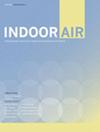A Comprehensive Index for Evaluating the Effectiveness of Ventilation-Related Infection Prevention Measures with Energy Considerations: Development and Application Perspectives
IF 4.3
2区 环境科学与生态学
Q1 CONSTRUCTION & BUILDING TECHNOLOGY
引用次数: 0
Abstract
In the wake of the COVID-19 pandemic, prioritizing indoor air quality has emerged as a crucial measure for preventing infections. Effective ventilation is vital in mitigating airborne pathogen transmission and maintaining a healthy indoor environment by diluting and removing infectious particles from enclosed spaces. However, increasing the supply of pathogen-free air to enhance infection control can lead to a rise in energy consumption. Nevertheless, evaluating the overall efficacy of ventilation-based infection prevention strategies while considering their energy requirements has posed challenges. This scientific paper introduces the ICEE (Infection Control’s Energy Efficiency) index, a newly developed simple integrated index to assess the effectiveness of ventilation strategies in reducing infection risks while accounting for associated energy demands. The paper reviews the current understanding of ventilation strategies, their impact on infection prevention, and their corresponding energy consumption. By employing a straightforward analytical approach, this metric offers a comprehensive framework to optimize ventilation systems for both infection prevention and energy efficiency. To quantify infection risk, a simplified equation model is utilized, incorporating factors such as ventilation effectiveness and filter efficiency, in case of recirculation. Energy demand is determined using approximations and relevant values from existing literature. Reference cases are defined, distinguishing between natural and mechanically ventilated scenarios, as these reference situations influence the energy-related effects of any implemented measures. The paper outlines the methodology employed to develop the index and illustrates its applicability through exemplary measures. The proposed index yields valuable insights for the design, operation, and retrofitting of ventilation systems, enabling informed decision-making towards fostering a healthier and more sustainable built environment.评估与通风相关的感染预防措施有效性的综合指标,其中考虑到能源因素:开发与应用视角
COVID-19 大流行之后,优先考虑室内空气质量已成为预防感染的关键措施。通过稀释和清除密闭空间中的传染性微粒,有效的通风对于减少空气中病原体的传播和维持健康的室内环境至关重要。然而,为加强感染控制而增加无病原体空气的供应可能会导致能耗增加。然而,评估基于通风的感染预防策略的整体效果,同时考虑其能源需求,一直是个难题。本科学论文介绍了 ICEE(感染控制能效)指数,这是一种新开发的简单综合指数,用于评估通风策略在降低感染风险方面的有效性,同时考虑相关的能源需求。论文回顾了目前对通风策略、其对预防感染的影响以及相应能耗的理解。通过采用简单明了的分析方法,该指标提供了一个综合框架,用于优化通风系统,以达到预防感染和提高能效的目的。为了量化感染风险,我们使用了一个简化方程模型,其中包含了通风效果和过滤器效率等因素。能源需求是利用现有文献中的近似值和相关值确定的。对参考案例进行了定义,区分了自然通风和机械通风两种情况,因为这些参考情况会影响任何已实施措施的能源相关效果。本文概述了开发该指数所采用的方法,并通过示范措施说明了其适用性。所提出的指数可为通风系统的设计、运行和改造提供有价值的见解,使人们能够在知情的情况下做出决策,从而营造更健康、更可持续的建筑环境。
本文章由计算机程序翻译,如有差异,请以英文原文为准。
求助全文
约1分钟内获得全文
求助全文
来源期刊

Indoor air
环境科学-工程:环境
CiteScore
10.80
自引率
10.30%
发文量
175
审稿时长
3 months
期刊介绍:
The quality of the environment within buildings is a topic of major importance for public health.
Indoor Air provides a location for reporting original research results in the broad area defined by the indoor environment of non-industrial buildings. An international journal with multidisciplinary content, Indoor Air publishes papers reflecting the broad categories of interest in this field: health effects; thermal comfort; monitoring and modelling; source characterization; ventilation and other environmental control techniques.
The research results present the basic information to allow designers, building owners, and operators to provide a healthy and comfortable environment for building occupants, as well as giving medical practitioners information on how to deal with illnesses related to the indoor environment.
文献相关原料
| 公司名称 | 产品信息 | 采购帮参考价格 |
|---|
 求助内容:
求助内容: 应助结果提醒方式:
应助结果提醒方式:


